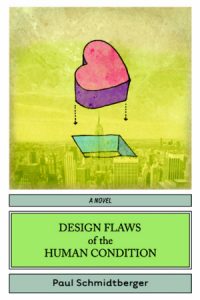The Story Behind the Book
DESIGN FLAWS OF THE HUMAN CONDITION by Paul Schmidtberger
Like most of my better ideas, the inspiration for Design Flaws of the Human Condition came to me in a bar.
It was in Paris and I was downstairs waiting to use the bathroom while precious Happy Hour minutes ticked away upstairs, only whoever was in there was taking his sweet time. This is the same kind of person who dashes ahead of you into the bathroom in a movie theater right before the movie starts and then makes himself at home and does crossword puzzles or fills out questionnaires aimed at figuring out which career is secretly perfect for him. I hate people like that.
So how do you get somebody else out of the bathroom that you would like to occupy? You don’t. The person inside holds all the cards. Unless, of course, you’re a locksmith, which – tragically – I’m not.
And then it hit me. The light switch. In France, the light switch is always on the outside of the bathroom. God only knows why they do like that, but they do. So if there’s no way to dislodge the person inside, you can at least make his stay there a little less comfortable. Which is to say, pitch black. And it worked!
It’s hard to understand how an entire country like France can get something as simple as where the light switch goes wrong, but they managed to do it. This system never would’ve worked where I grew up. I grew up in a household of six kids who shared one windowless bathroom. And believe me, if the light switch were on the outside, every time I walked by and saw the door closed with the switch on, I’d turn it off. Why? Well, why not?
But fun and games aside, the placement of the light switch in the bar is what’s known as a “design flaw,” something we were always reading about in law school. The theory of design flaws is that certain products contain imperfections which, with a little extra thinking, might’ve been avoided. The classic example is the Ford Pinto. It was little. It was zippy. It was named after a horse with daring, devil-may-care splashes of color. What’s not to like about it? Well, the fact that they put the gas tank under the rear axle, which meant that it exploded on impact. A great design, just not perfect.
So my inspiration that night was to take the dry, dusty theory of a design flaw and apply it to living, breathing people. People are an absolute miracle of design. We come in all sorts of neat shapes and sizes. We’re resilient (“Try pouring a bottle of bourbon down your toaster and see just how well it works the next day”). But we’re not perfect.
Take love, for example. We humans have a built-in capacity to fall in love that outshines any technological marvel we could ever dream of. But bundled right into that gift is our capacity for infidelity. And that’s what I wanted to write about. I wanted to see how you can reconcile the fact that our capacity for love includes a flaw – the capacity for infidelity.
Once I had that kernel of an idea, the rest of the book fell into place. I set the book in New York because I wanted my characters to meet and plot their revenge in an anger management seminar, so I needed a city where people carried around a lot of pent-up bile and New York seemed to fit the bill. Then I used two different couples so that I could explore the full spectrum of infidelity: one couple confronts a brazenly clear case of infidelity while the second wrestles with its mere possibility.
But mostly I chose this structure because it allowed for my two main protagonists to become friends, no matter what happened with their respective relationships. They began the book as strangers linked by nothing more than a set of squealing brakes and a minor accident on the West Side Highway, but they finish the book as friends. And that’s exactly the design I had in mind.

